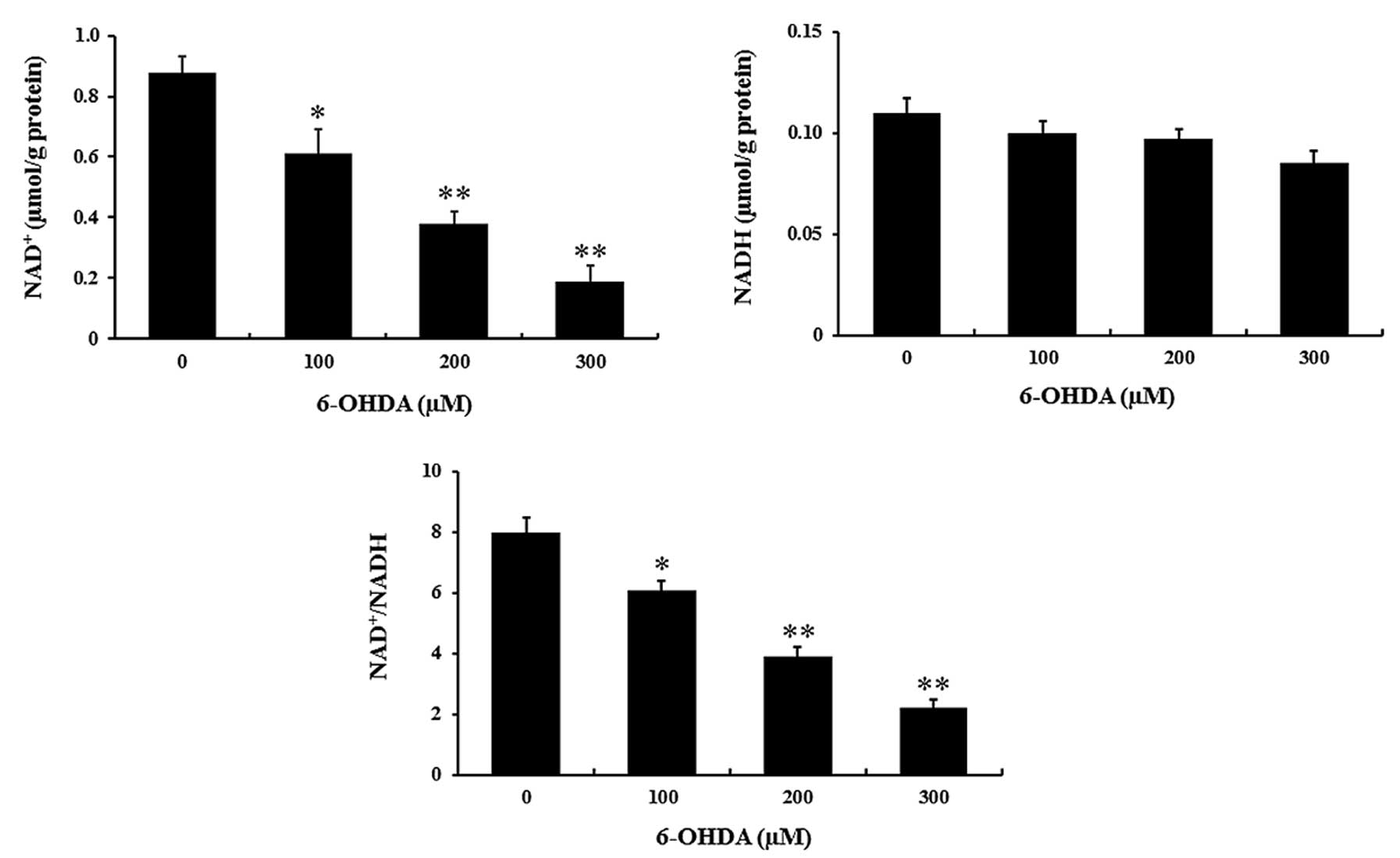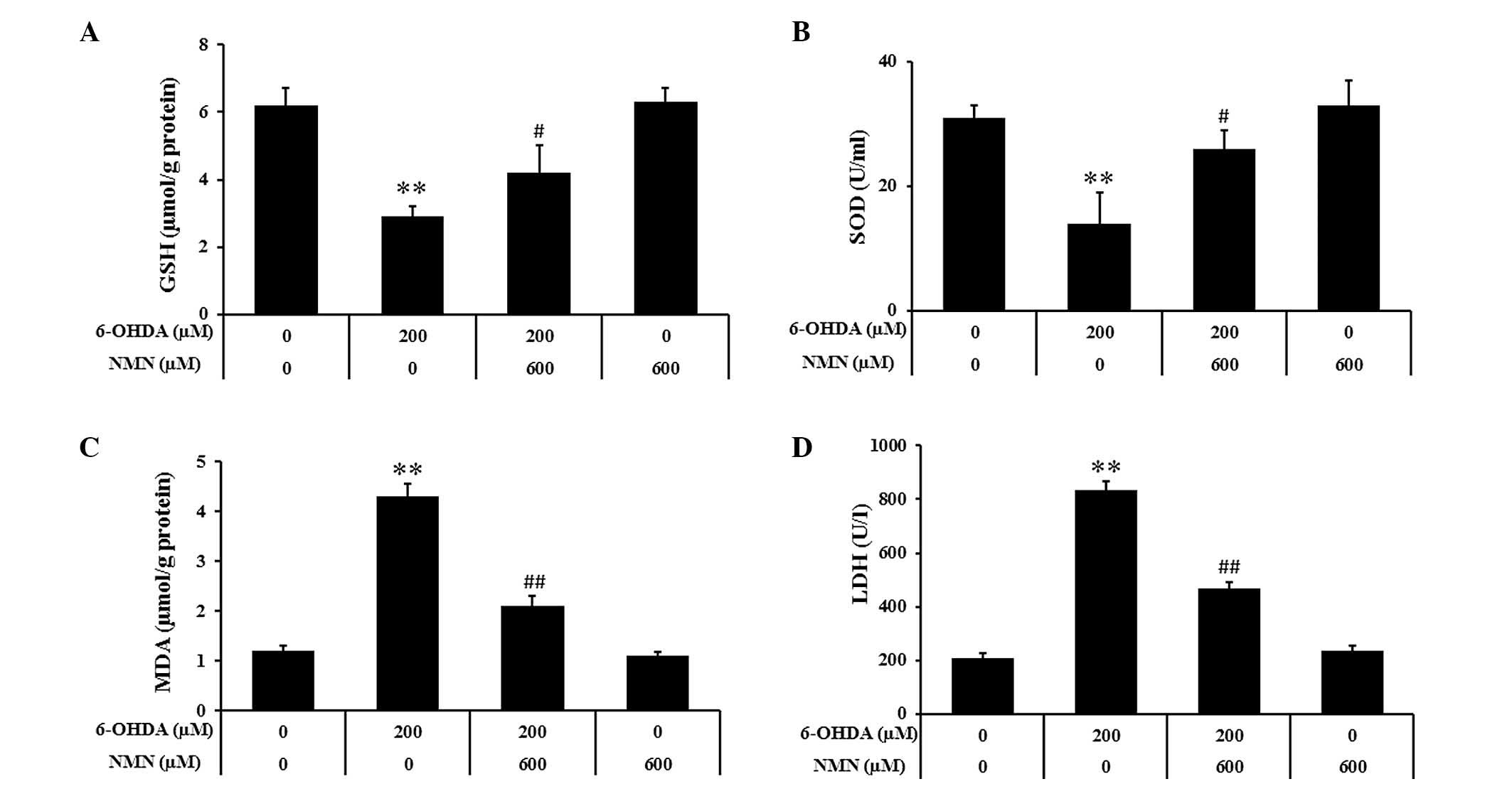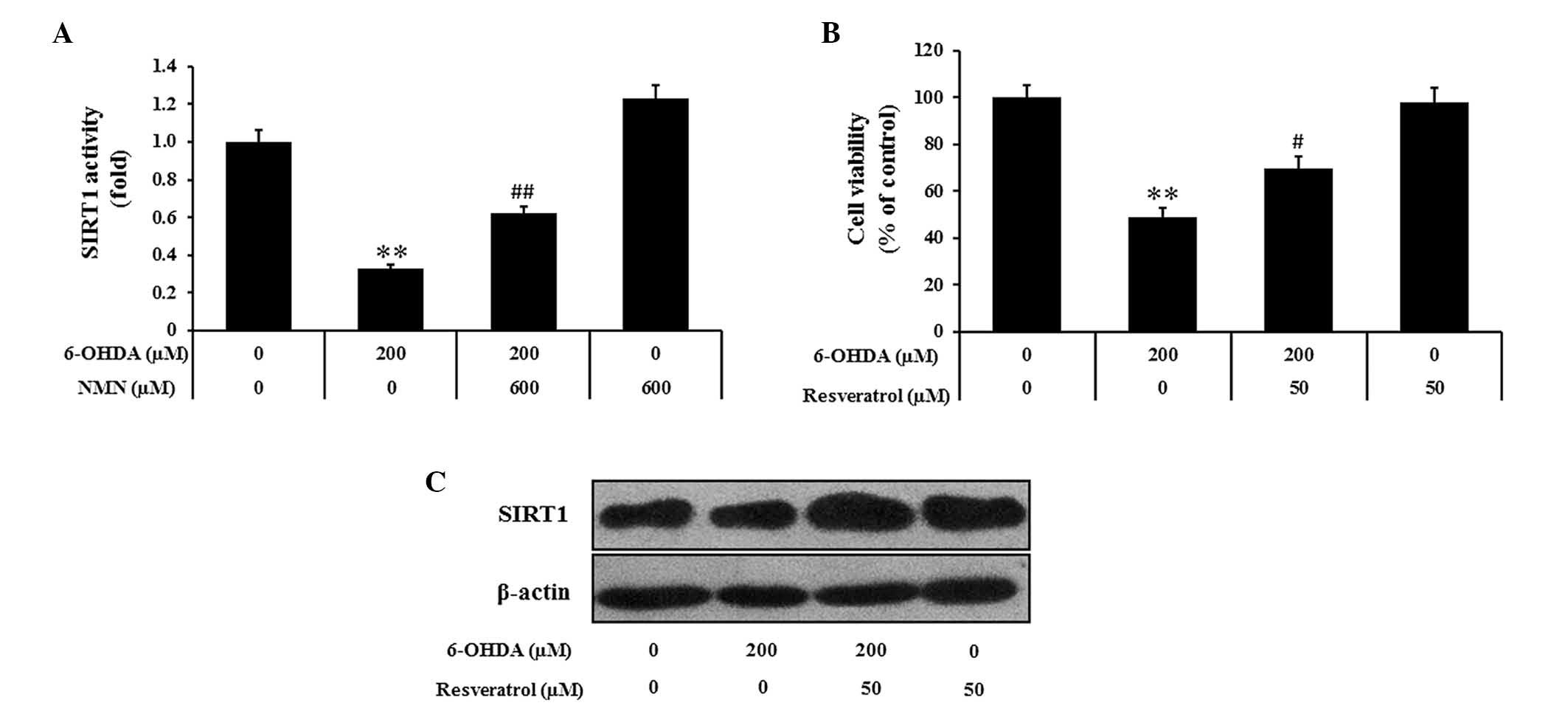|
1
|
Beal MF: Experimental models of
Parkinson's disease. Nat Rev Neurosci. 2:325–334. 2001. View Article : Google Scholar : PubMed/NCBI
|
|
2
|
Hanrott K, Gudmunsen L, O'Neill MJ and
Wonnacott S: 6-hydroxydopamine-induced apoptosis is mediated via
extracellular auto-oxidation and caspase 3-dependent activation of
protein kinase Cdelta. J Biol Chem. 281:5373–5382. 2006. View Article : Google Scholar
|
|
3
|
Blandini F, Armentero MT and Martignoni E:
The 6-hydroxy-dopamine model: News from the past. Parkinsonism
Relat Disord. 14(Suppl 2): S124–S129. 2008. View Article : Google Scholar
|
|
4
|
Surendran S and Rajasankar S: Parkinson's
disease: Oxidative stress and therapeutic approaches. Neurol Sci.
31:531–540. 2010. View Article : Google Scholar : PubMed/NCBI
|
|
5
|
Soto-Otero R, Méndez-Alvarez E,
Hermida-Ameijeiras A, Muñoz-Patiño AM and Labandeira-Garcia JL:
Autoxidation and neurotoxicity of 6-hydroxydopamine in the presence
of some antioxidants. J Neurochem. 74:1605–1612. 2000. View Article : Google Scholar : PubMed/NCBI
|
|
6
|
Han XH, Cheng MN, Chen L, Fang H, Wang LJ,
Li XT and Qu ZQ: 7,8-dihydroxyflavone protects PC12 cells against
6-hydroxydopamine-induced cell death through modulating PI3K/Akt
and JNK pathways. Neurosci Lett. 581:85–88. 2014. View Article : Google Scholar : PubMed/NCBI
|
|
7
|
Xu DP, Zhang K, Zhang ZJ, Sun YW, Guo BJ,
Wang YQ, Hoi PM, Han YF and Lee SM: A novel tetramethylpyrazine
bisnitrone (TN-2) protects against 6-hydroxyldopamine-induced
neurotoxicity via modulation of the NF-κB and the PKCα/PI3-K/Akt
pathways. Neurochem Int. 78:76–85. 2014. View Article : Google Scholar : PubMed/NCBI
|
|
8
|
Wang L, Wang R, Jin M, Huang Y, Liu A, Qin
J, Chen M, Wen S, Pi R and Shen W: Carvedilol attenuates
6-hydroxydo-pamine-induced cell death in PC12 Cells: Involvement of
Akt and Nrf2/ARE pathways. Neurochem Res. 39:1733–1740. 2014.
View Article : Google Scholar : PubMed/NCBI
|
|
9
|
Imai SI, Armstrong CM, Kaeberlein M and
Guarente L: Transcriptional silencing and longevity protein Sir2 is
an NAD-dependent histone deacetylase. Nature. 403:795–800. 2000.
View Article : Google Scholar : PubMed/NCBI
|
|
10
|
Rongvaux A, Shea RJ, Mulks MH, Gigot D,
Urbain J, Leo O and Andris F: Pre-B-cell colony-enhancing factor,
whose expression is up-regulated in activated lymphocytes, is a
nicotinamide phosphoribosyltransferase, a cytosolic enzyme involved
in NAD biosynthesis. Eur J Immunol. 32:3225–3234. 2002. View Article : Google Scholar
|
|
11
|
Revollo JR, Grimm AA and Imai S: The
regulation of nicotinamide adenine dinucleotide biosynthesis by
Nampt/PBEF/visfatin in mammals. Curr Opin Gastroenterol.
23:164–170. 2007. View Article : Google Scholar : PubMed/NCBI
|
|
12
|
Revollo JR, Grimm AA and Imai S: The NAD
biosynthesis pathway mediated by nicotinamide
phosphoribosyltransferase regulates Sir2 activity in mammalian
cells. J Biol Chem. 279:50754–50763. 2004. View Article : Google Scholar : PubMed/NCBI
|
|
13
|
Ying W: NAD+/NADH and
NADP+/NADPH in cellular functions and cell death: Regulation and
biological consequences. Antioxid Redox Signal. 10:179–206. 2008.
View Article : Google Scholar
|
|
14
|
Furukawa A, Tada-Oikawa S, Kawanishi S and
Oikawa S: H2O2 accelerates cellular
senescence by accumulation of acetylated p53 via decrease in the
function of SIRT1 by NAD+ depletion. Cell Physiol
Biochem. 20:45–54. 2007.
|
|
15
|
Lu L, Tang L, Wei W, Hong Y, Chen H, Ying
W and Chen S: Nicotinamide mononucleotide improves energy activity
and survival rate in an in vitro model of Parkinson's disease. Exp
Ther Med. 8:943–950. 2014.PubMed/NCBI
|
|
16
|
Milne JC, Lambert PD, Schenk S, Carney DP,
Smith JJ, Gagne DJ, Jin L, Boss O, Perni RB, Vu CB, et al: Small
molecule activators of SIRT1 as therapeutics for the treatment of
type 2 diabetes. Nature. 450:712–716. 2007. View Article : Google Scholar : PubMed/NCBI
|
|
17
|
Araki T, Sasaki Y and Milbrandt J:
Increased nuclear NAD biosynthesis and SIRT1 activation prevent
axonal degeneration. Science. 305:1010–1013. 2004. View Article : Google Scholar : PubMed/NCBI
|
|
18
|
Tanno M, Kuno A, Yano T, Miura T, Hisahara
S, Ishikawa S, Shimamoto K and Horio Y: Induction of manganese
superoxide dismutase by nuclear translocation and activation of
SIRT1 promotes cell survival in chronic heart failure. J Biol Chem.
285:8375–8382. 2010. View Article : Google Scholar : PubMed/NCBI
|
|
19
|
Liu T, Liu PY and Marshall GM: The
critical role of the class III histone deacetylase SIRT1 in cancer.
Cancer Res. 69:1702–1705. 2009. View Article : Google Scholar : PubMed/NCBI
|
|
20
|
Cohen HY, Miller C, Bitterman KJ, Wall NR,
Hekking B, Kessler B, Howitz KT, Gorospe M, de Cabo R and Sinclair
DA: Calorie restriction promotes mammalian cell survival by
inducing the SIRT1 deacetylase. Science. 305:390–392. 2004.
View Article : Google Scholar : PubMed/NCBI
|
|
21
|
Salminen A, Huuskonen J, Ojala J,
Kauppinen A, Kaarniranta K and Suuronen T: Activation of innate
immunity system during aging: NF-kB signaling is the molecular
culprit of inflamm-aging. Ageing Res Rev. 7:83–105. 2008.
View Article : Google Scholar
|
|
22
|
Chen WY, Wang DH, Yen RC, Luo J, Gu W and
Baylin SB: Tumor suppressor HIC1 directly regulates SIRT1 to
modulate p53-dependent DNA-damage responses. Cell. 123:437–448.
2005. View Article : Google Scholar : PubMed/NCBI
|
|
23
|
Hasegawa K, Wakino S, Yoshioka K,
Tatematsu S, Hara Y, Minakuchi H, Washida N, Tokuyama H, Hayashi K
and Itoh H: Sirt1 protects against oxidative stress-induced renal
tubular cell apoptosis by the bidirectional regulation of catalase
expression. Biochem Biophys Res Commun. 372:51–56. 2008. View Article : Google Scholar : PubMed/NCBI
|
|
24
|
Jeong J, Juhn K, Lee H, Kim SH, Min BH,
Lee KM, Cho MH, Park GH and Lee KH: SIRT1 promotes DNA repair
activity and deacetylation of Ku70. Exp Mol Med. 39:8–13. 2007.
View Article : Google Scholar : PubMed/NCBI
|
|
25
|
Bu Q, Yang Y, Yan G, Hu Z, Hu C, Duan J,
Lv L, Zhou J, Zhao J, Shao X, et al: Proteomic analysis of the
nucleus accumbens in rhesus monkeys of morphine dependence and
withdrawal intervention. J Proteomics. 75:1330–1342. 2012.
View Article : Google Scholar
|
|
26
|
Zhao X, Zhai S, An MS, Wang YH, Yang YF,
Ge HQ, Liu JH and Pu XP: Neuroprotective effects of protocatechuic
aldehyde against neurotoxin-induced cellular and animal models of
Parkinson's disease. PloS One. 8:e782202013. View Article : Google Scholar : PubMed/NCBI
|
|
27
|
Blum D, Torch S, Lambeng N, Nissou M,
Benabid AL, Sadoul R and Verna JM: Molecular pathways involved in
the neurotoxicity of 6-OHDA, dopamine and MPTP: Contribution to the
apoptotic theory in Parkinson's disease. Prog Neurobiol.
65:135–172. 2001. View Article : Google Scholar : PubMed/NCBI
|
|
28
|
Schober A: Classic toxin-induced animal
models of Parkinson's disease: 6-OHDA and MPTP. Cell Tissue Res.
318:215–224. 2004. View Article : Google Scholar : PubMed/NCBI
|
|
29
|
Saito Y, Nishio K, Ogawa Y, Kinumi T,
Yoshida Y, Masuo Y and Niki E: Molecular mechanisms of
6-hydroxydopamine-induced cytotoxicity in PC12 cells: Involvement
of hydrogen peroxide-dependent and-independent action. Free Radic
Biol Med. 42:675–685. 2007. View Article : Google Scholar : PubMed/NCBI
|
|
30
|
Fujita H, Ogino T, Kobuchi H, Fujiwara T,
Yano H, Akiyama J, Utsumi K and Sasaki J: Cell-permeable cAMP
analog suppresses 6-hydroxydopamine-induced apoptosis in PC12 cells
through the activation of the Akt pathway. Brain Res. 1113:10–23.
2006. View Article : Google Scholar : PubMed/NCBI
|
|
31
|
Yang T and Sauve AA: NAD metabolism and
sirtuins: Metabolic regulation of protein deacetylation in stress
and toxicity. AAPS J. 8:E632–E643. 2006. View Article : Google Scholar
|
|
32
|
Bürkle A: Poly (ADP-ribose). The most
elaborate metabolite of NAD+. FEBS J. 272:4576–4589.
2005. View Article : Google Scholar
|
|
33
|
Halliwell B: Oxidative stress and
neurodegeneration: Where are we now? J Neurochem. 97:1634–1658.
2006. View Article : Google Scholar : PubMed/NCBI
|
|
34
|
Zhang T and Kraus WL: SIRT1-dependent
regulation of chromatin and transcription: Linking NAD metabolism
and signaling to the control of cellular functions. Biochim Biophys
Acta. 1804:1666–1675. 2010. View Article : Google Scholar :
|



















